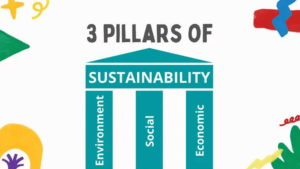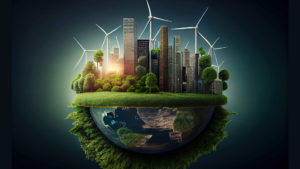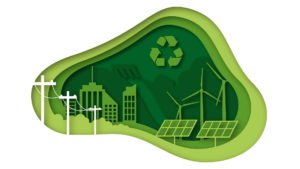Sustainable 3 pillars are about a healthy environment, a just society, and a strong economy. Sustainability works to fulfill demands now without risking future generations with important tactics like encouraging the circular economy, switching to renewable energy, and responsible consumption.
Global solutions related to sustainability are about a balance in the environmental, social, and economic spheres.
The environment we live in has social societies and interactions are run by economic growth. All the environmental, social, and economic factors are related to each other. Therefore, they are the pillars, giving strength and force.
Sustainable three pillars are a must for the future if we want to have good for the long term.
The Earth won’t be saved by a few recycling containers. A global awakening with sustainable global solutions is required.
What Is Sustainability?

Sustainability is protecting our planet and guaranteeing that we can live on it for a very long time without compromising it or reducing its resources.
Using resources responsibly and finding ways to balance our wants with what the Earth can give over a long period of time is sustainability, it’s the same as being responsible and making sure that our actions do not negatively impact the world for future generations.
Protecting the environment, preserving resources, and living in harmony with the planet are the main views of sustainability.
In simpler words, the ability to satisfy the requirements of the present generation without compromising the ability of future generations to meet their own needs is known as sustainability.
An a-Pillar of sustainability supports its broader meanings.
Sustainability encourages global solutions like ethical labor practices, waste reduction, the use of renewable energy, responsible resource management, and reflection of the broader effects that human activity has on the environment and society.
It is a many-sided strategy that finds to achieve a harmonic balance between environmental health, social well-being, and economic growth for both the present and future generations.
Sustainability is an understanding of and respect for nature and Living sustainably means being in tune with the environment.
Sustainable 3 pillars are like the global solutions that work wonders.
We can also think of it as If one wanted their children and grandkids to prosper.
What would they do?
Certainly, they had to look after the land and its resources. If too many trees are cut down, they would result in less clean air and a loss of wildlife habitat. So whenever they cut down a tree, they should plant a new one to keep the forest lush and vibrant for future generations.
Similarly, the rivers and lakes that supplied water for their crops and livestock were valued knowing that clean water is necessary for life; therefore, never pollute the water sources and always maintained them clean.
Sustainability and sustainable three pillars are like nursing to a garden. The garden as a pillar of sustainability will continue to provide for us if we only take what we need from it and make sure to sow new seeds. The garden will weaken away if we take too much or ignore it, and then there will be nothing left.
We are the final generation that can stop climate change and the first generation to experience its effects.
What Are Sustainable 3 Pillars? (Three Pillars of Sustainability)

The sustainable three pillars of environmental, social, and economic sustainability are the basis of sustainability.
Achieving a harmonic balance between the needs of the present and the expectations of future generations depends on each pillar because it supports a sustainable future.
1. Environmental Sustainability: Protecting the Environment and the Planet
To maintain ecological balance and confirm the health of our planet, the environmental pillar of sustainability places a strong importance on maintaining and protecting the natural world.
So, how to protect the environment and the planet, here are the Key elements of the environmental pillar of sustainability:

- Responsible Resource Management: To prevent resource lessening, use natural resources wisely and effectively. Ensuring that resources are renewed and are available for future generations, requires supporting sustainable practices in sectors including forestry, agriculture, and mining.
- Biodiversity conservation: To maintain the delicate balance of nature; safeguard endangered species and various ecosystems. Ecosystem stability and resilience depend on biodiversity.
- Easing of Climate Change: Take action to lessen greenhouse gas emissions and fight climate change as global solutions. Promote energy efficiency across all sectors and make the transition to renewable energy sources including solar, wind, and hydropower.
- Waste Reduction and Recycling: To lessen the burden on landfills and conserve resources as global solutions, minimize waste output, and put in place efficient recycling programs.
- Sustainable Land Use: Plan your land use wisely to avoid destroying habitat and causing urban spread. Promote parks and other green spaces.
The damage we are causing to the world’s forests is merely a reflection of the harm we are causing to ourselves and to one another.
2. Social sustainability: Building open and prosperous societies
The focus of the social pillar of sustainability is on the fairness and well-being of people within a society. It involves building a society in which everyone has access to the needs of life and chances for development. Key components of the social pillar of sustainability include:
- Access to Education and Healthcare: Ensure that everyone has access to high-quality education and healthcare, empowering them to realize their full potential.
- Fair Labor Practices: To establish a just and successful workforce, promote fair salaries, safe working conditions, and respect for employees’ rights.
- Inclusive Communities: Encourage strong and interconnected communities that value and celebrate global solutions.
- Poverty Alleviation: Reduce poverty and inequality by putting in place social safety nets and giving assistance to weaker groups.
- Protecting human rights and promoting equality for all, regardless of gender, race, ethnicity, or other considerations.
The environment is where we all come together, where we all share a common interest, global solutions and it is what unites us all.
3. Economic Sustainability: Balancing Long-Term Stability and Prosperity

The key to an economic pillar of sustainability is creating a strong economy that can meet current demands while protecting future ones. Key components of the economic pillar of sustainability include:
- Making responsible financial decisions: It means avoiding actions that abuse resources or future generations and considering the long-term effects on society and the environment
- Innovation and Adaptation: Promote innovation to develop environmentally and economically advantageous sustainable technology, goods, and services.
- Promote the circular economy: It focuses on repairing, reusing, and recycling things to cut down on waste and save resources.
- Encourage companies to use ethical business methods: It put social duty and environmental responsibility above profit.
- Green Technologies and Industries: Invest in these sectors to develop new employment possibilities that support sustainability initiatives.
We can all work together to create a future that balances human needs with the health of the world by understanding and taking on the Sustainable 3 pillars: environmental, social, and economic.
Without environmental and social responsibility, economic expansion will continue to be a disaster.
How Important It Is To Accept The Sustainable Three Pillars?

For numerous compelling reasons, it is important to accept and hold the Three Pillars of Sustainability (environmental, social, and economic):
Sustainable 3 pillars Environmental, social, and economic sustainability form the firm foundation upon which sustainability, the secret to a prosperous and peaceful world, is built. These pillars work together to create a complete framework that directs us toward a future in which people and the world live in harmony.
-
The environmental pillar of sustainability is centered on preserving and safeguarding the environment that supports us. It involves conserving biodiversity, managing the effects of climate change, and using resources responsibly. We can preserve healthy earth for the present and future generations by implementing eco-friendly behaviors like recycling, taking on renewable energy, and conserving habitats.
-
The foundation of the social pillar of sustainability is the creation of alive, all-encompassing communities. It requires safeguarding that everyone has access to healthcare, education, and fundamental human rights while also encouraging ethical business conduct and valuing cultural diversity. We build a society where everyone can live happy lives and contribute to a brighter future by putting a priority on social fairness and helping disadvantaged groups.
-
Building a strong, economic pillar of sustainability that supports social and environmental well-being is the goal of economic sustainability. To achieve economic prosperity without risking the planet’s resources, responsible financial decisions, green innovation, and a circular economy model are essential. We pave the road for sustainable growth that benefits all stakeholders by taking on ethical business practices and investing in green sectors.
The 3 pillar of sustainability are linked and dependent on one another. Social inequality and environmental dreadful conditions both have an impact on society’s well-being.
Similar to how an unhealthy economy can result in social injustice and environmental abuse. Understanding these links of global solutions is essential for developing successful sustainability strategies that tackle problems at their source and provide comprehensive solutions.
Individuals, companies, governments, and organizations must work together to hold the sustainable three pillars.
Each of us is essential in bringing about change for the better. Our actions help create a more sustainable future, whether it’s through incorporating environmentally good habits into our daily lives, approving socially conscious companies, or pushing for sustainable laws.
Accepting the Sustainable 3 pillars is a need, not just a choice. It provides a road map for a just and successful future where people coexist peacefully with the environment.
Sustainability is a lasting legacy that we are pleased to leave for future generations.
We are acting as though we have another planet after this one. No! We are having zero choices for escape.
Important Information And Stats Related To The Need For Sustainability And Global Solutions

- If consumption tendencies stay the same, Earth will run out of resources in around 27 years.
- In the last 40 years, the destruction of one-third of Earth’s soil has been attributed to increasing food consumption and agricultural practices.
- With an average of 1,609 pounds of rubbish produced per person each year, the United States is the world’s largest producer of garbage.
- Each week, 500,000 trees are chopped to make Sunday newspapers as opposed to global solutions.
- In the US, almost 12 million cars are recycled annually.
- Only 1% of the water on Earth is fit for human use, and more than a billion people lack access to clean water.
- An American home wastes 180 gallons of water on average every week.
- One pair of jeans requires 1,850 gallons of water to make.
- While 811 million people go hungry, 33% of the food produced worldwide is lost or wasted.
- To satisfy world demand as global solutions, food output must rise by 60% by 2050.
- Another risk to the sustainable three pillars of agriculture is soil erosion brought on by food production, climate change, and deforestation.
- Globally, Malta has the lowest recycling rate (7%), while Austria has the highest (63%).
- The amount of rubbish produced by people has increased by 10,000% in the last century.
What A Person Can Do To Promote Sustainability/ Sustainable 3 Pillars?
People have been essential to promoting sustainability and safeguarding the environment.
- Adopt the 3 R’s philosophy in daily life by reducing, reusing, and recycling. Reduce excessive consumption, repurpose objects whenever you can, and recycle products like paper, plastic, glass, and metal to reduce trash as global solutions.
- Use energy-efficient appliances and lighting, shut off the lights when not in use, and unplug any electronic devices when they are finished charging or not in use to conserve energy.
- Fix leaks, use water-saving fixtures, cut the length of your showers, and switch off the taps while you are washing your dishes or brushing your teeth to save water.
- To reduce carbon emissions as global solutions, choose sustainable transportation options like walking, cycling, or using the bus or train. If a car is required, think about adopting an electric or hybrid model.
- Promote and support the use of renewable energy sources s global solutions, such as solar, wind, and hydroelectricity.
- Adopt Planting Trees and Vegetation. Help fight deforestation by taking part in tree-planting campaigns and establishing native plant-filled green spaces.
- Reduce the usage of single-use plastic by avoiding straws, bottles, and bags. Pick reusable substitutes made of eco-friendly materials.
- Choose products from businesses dedicated to sustainability, moral behavior, and environmental responsibility to support sustainable three pillars.
- Eat sustainably by consuming less meat, buying locally and organically grown food, and minimizing food waste.
- Support for environmentally friendly policies and practices in your neighborhood and beyond by educating yourself and others about 3 pillar of sustainability.
- Participate in Local Cleanup Events. Help keep public places and natural areas clean by taking part in neighborhood clean-up events as a pillar of sustainability.
- Adopt Eco-friendly Habits as global solutions including utilizing reusable shopping bags, cloth napkins in place of disposable ones, and refillable water bottles.
- Composting organic waste can help minimize waste sent to landfills and produce soil that is rich in nutrients for gardening.
- Contribute to and volunteer with organizations that safeguard wildlife and natural ecosystems to support conservation efforts.
- Reduce Meat Consumption. To lessen the environmental impact of meat production, consider switching to a plant-based diet or participating in meatless days.
- Even little individual actions, when combined, can have a big impact on the globe. Individuals can together contribute to a greener and more sustainable future for all by making sustainable decisions in their daily lives.
The Ending Notes
So, here we reach the end of the most important Sustainable 3 pillars as global solutions.
There has never been a more pressing need to act and adopt sustainable methods. Each of us has the ability to change things and help ensure that the planet is healthy for coming generations.
Economic sustainability, environmental safety, and social equality are1 the three pillars of sustainability.
Environmental sustainability and ethical responsibility go hand in hand because it is morally right for people to protect the environment and its resources.
If we destroy the environment, we won’t have a society. The belief that someone else will save the earth is the biggest threat to it.
Let us create Sustainable 3 pillars and a sustainable harmony for the future of our planet in the symphony of life.
Let us all work together to protect the beauty of the Earth for future generations with sustainable three pillars.
The legacy we leave for future generations depends on the decisions we make now.
Let us lead by example and leave a lasting legacy of kindness and compassion for all living things. We can improve the planet by working together on global solutions.
Let us build a future where people and nature coexist peacefully. With each step we take today, the journey begins, and the benefits are enormous.
Adopt sustainability now!
It is true that we all have been equally responsible for the bad happening in the world, so why not take responsibility and let us all prove the good and let us sustain ourselves together.
Consider the numbers and facts about Sustainable 3 pillars presented here, and then ask you: What part can I play in nurturing environmental awareness and sustainability in my day-to-day activities?














